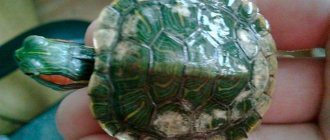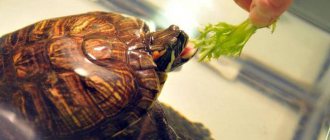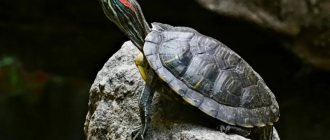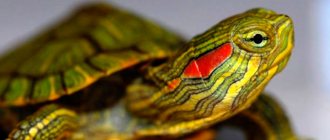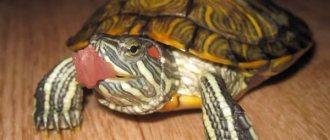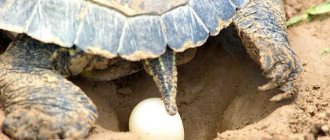Red-eared turtles are very colorful and stylish pets. Many owners purchase unusual exotic animals at a young age precisely for their cheerful colors. The bright lime or green shell in combination with red stripes on the neck and yellow-orange spots on the skin and back evokes affection in most people. If your red-eared turtle's shell has darkened or black spots have appeared on its back, do not panic and look for symptoms of disease in your aquatic pet. Most often, such a change in the color of the shell is associated with the maturation of a small reptile and its adaptation to environmental conditions.
Diseases of red-eared turtles and their treatment. How to identify red-eared turtle disease?
For the first time they learned about red-eared turtles in Europe in the middle of the 16th century.
They were described by the Spaniard Pedro Cieza de Leon. Over time, these small but very cute animals were able to conquer many hearts and became beloved pets in many families around the world. However, not all owners know how to care for these cute creatures. How to identify red-eared turtle disease? How to help your pet? We will try to answer these and many other questions in our article.
Hygiene
Hygiene rules for reptiles are simple and easy to do at home. From time to time, the pet turtle is bathed in a separate container. The water should be warm (above 36 degrees) and cover the animal by two-thirds. It is recommended to add chamomile infusion. If your reptile defecates during water procedures, immediately change the water to clean water.
A hard brush is not suitable for this purpose; take a soft cloth. Do not use foaming products (shampoo, soap) for washing. A dark coating on the shell is algae or fungus. Remove it with special products from the pet store.
Claws are trimmed as needed using reptile clippers.
Carefully! The claws have blood vessels that cannot be injured during the procedure. You can determine their location in the light
At least once a month, the aquaterrarium is thoroughly cleaned:
- The island and walls are washed with a solution of baking soda.
- Decorative elements are washed and treated with boiling water.
- The soil is calcined in the oven.
Red-eared slider - description
This turtle is medium sized. The length of its shell ranges from 18 to 30 cm. This depends on the sex of the animal and the subspecies. Males are much smaller than females. Young animals are distinguished by a bright green shell, which becomes yellow-brown or olive with age. It is decorated with patterns of yellow stripes.
There is also a pattern on the neck, head and limbs of the turtles. It consists of green and white spots, as well as wavy stripes. The animal got its name because of two bright red or orange spots located on the sides of its head. The bottom of the shell is usually oval, dark in color with bright yellow lines.
Article on the topic: Why do hamsters run in a wheel?
Breeding turtles
A turtle's readiness to reproduce depends on its size. The length of males should be more than 10 cm, and females should be more than 12-13 cm. The male begins to court the female. He swims near the female, pokes his muzzle into her muzzle and waves his paws. In the wild, turtles breed in March and June, and at home at any time of the year.
For a pregnant turtle, it is necessary to provide a place where it will lay eggs. There may be two dozen eggs in a clutch. In good conditions there are 3-4 clutches per year. If the female is ready to breed, she becomes active, tries to dig something and tries to get out of the aquarium. At the same time, he spends most of his time on the island. If the female lays one or two eggs, then make her a nest. And remember that most likely she carries the remaining eggs further.
If the turtle does not lay eggs, but continues to carry them, this can lead to the development of an infection and its death. If the eggs are still not laid, then immediately take her to the veterinarian.
Baby just hatched from an egg
Habitat
Under natural conditions, this species of turtle lives in small lakes and ponds with low and often swampy shores. Leads a calm and measured lifestyle. The animal is very curious. When the turtle is full, it climbs ashore and basks in the sun. If she gets hungry, she will swim slowly, looking for prey.
When the water temperature drops to +18 °C, the turtle may become lethargic and lose its appetite. This leisurely animal notices danger at a distance of up to forty meters, after which it quickly slides into the water.
Arrangement of hibernation
The fact that a turtle should hibernate can be determined by the following external signs: the turtle moves little and, at the same time, yawns often. She can hide in a corner of the aquarium and remain motionless there for a long time. To begin with, you should consult a veterinarian and, if its behavior is not associated with any disease, begin preparing the turtle for hibernation.
Two months before hibernation begins, the turtle should increase its diet and the amount of feeding. This is necessary so that the turtle can stock up on all the necessary nutrients. During hibernation, the turtle loses up to half its weight.
Over the past week, the turtle has not been fed at all, and during the day it needs several bath procedures so that it can completely empty its intestines.
Red-eared turtle: conditions of detention, food and diseases
Keeping these animals is fraught with some difficulties. This species spends most of its life in water, but the turtle needs an island of land.
An adult needs a fairly spacious aquaterrarium, with a volume of at least 100 liters. Ideally, land should occupy approximately 25% of its area. Place soil or crushed stone on the shore. To make it convenient for the turtle to go onto land, it is necessary to build a gentle rise with a rough surface, but such that your pet will not get hurt on it. Most often, rough plastic is used for this purpose. Water should be poured into the terrarium in such a way that the turtle, if for some reason ends up on its back, can turn over.
Diseases in which the skin peels off
It is normal for a reptile's skin to peel and flake off during the molting period. As soon as the animal is raised, everything is over.
But sometimes peeling skin can be a sign of pathology.
The clinical picture of the following diseases resembles the molting process:
- Mycosis. Most often, a fungal infection develops in the spring, when the animal’s immunity is weakened, especially if it hibernated. With this disease, you can notice a white coating on the skin, which can be easily removed with a cotton swab. If the animal moves and touches various objects, then white stripes remain on them.
- Rickets. With this pathology, the shell becomes bent and may begin to peel off. The eyes may become swollen, causing them to close completely. Due to the curvature of the jaws, the turtle does not eat anything, which can cause death.
- Hypovitaminosis. If an animal’s diet is monotonous and it does not receive all the necessary vitamins, then it may develop vitamin deficiency. Hypovitaminosis A is manifested by peeling of the skin. There is desquamation of large scutes on the limbs and head, marginal blepharitis, in which the eyelids swell, and the cloaca prolapses. The reptile grows a “parrot-like” beak. Often, with hypovitaminosis A, a runny nose is observed, so the disease is confused with a bacterial infection. Also, the animal may not eat anything, which will cause the reptile to become exhausted. To prevent the development of vitamin A deficiency, the pet must constantly receive liver, fish entrails, carrots, and pumpkin.
To exclude these pathologies, it is advisable to show your pet to a herpetologist, who, if necessary, will select adequate therapy.
If this is not possible, then you should carefully examine the reptile. When the animal is active and does not exhibit any alarming symptoms, then most likely the peeling and detachment of the skin is associated with molting and there is no cause for concern. This means that the red-eared slider is developing correctly.
Water requirements
It is important to ensure that the water temperature does not fall below 20°C; the turtle feels most comfortable at 24-30°C. To maintain these conditions, you will need to install a heater.
Change the water as needed, about once a week. Using a water filter will allow you to do this less often. In any case, owners need to know that a complete change of water is carried out monthly.
How to care for a turtle during this period
As soon as the molting process has been detected, the turtle should immediately be provided with the necessary conditions. During this period, you cannot change your diet. The beginning of the process indicates normal growth and the diet should include foods that affect active growth. These are products that contain calcium and other important vitamins. To ensure that the turtle's body is replenished with calcium, small crustaceans and fish fry can be included in its diet. Various vitamin complexes intended for young individuals may not be superfluous.
During the molting process, active pollution of the water occurs with particles of dead skin and shell. Therefore, during this period, you should change the water more often so as not to start the rotting process. This is also necessary to ensure that the turtle does not pick up any infection, since young skin is not so resistant to the penetration of viruses.
Sometimes a turtle needs help. If it is noticed that the dead skin does not fall off for a long time and brings certain inconvenience to the turtle, then you can help remove this dead skin with some effort. If we assume that some areas of dead skin remain on the turtle, then the turtle itself will try to do this, after which wounds may appear on the surface of the skin, and this is extremely dangerous for its health.
Feeding
The issue of preparing your pet’s diet must be approached very responsibly. Very often, incorrectly selected food provokes red-eared turtle disease.
In an aquaterrarium, the diet of red-eared turtles should include small crustaceans (gammarus or shrimp). Your pet will not refuse small aquarium or river snails. You can finely chop ocean fish, meat, and liver.
Owners are often interested in the question of what diseases red-eared turtles carry. It should be noted that most pathologies are associated with the condition of the shell - softening, delamination, etc. This is often observed with a lack of calcium. To avoid such problems, it is necessary to include in the animal’s diet foods rich in this element - fish heads, bone meal, eggshells, chalk.
We must not forget about useful supplements in the form of plant foods. Turtles enjoy eating leaves of cabbage, dandelion, spinach, plantain, and lettuce. Among the algae, they will like elodea, duckweed, seaweed, edogonium, anacharis, and water beetle. Young turtles should be fed twice a day. Then they are transferred to a single meal. Reptiles over two years of age are fed no more than three times a week.
Cause
A turtle fungus affects the skin. This lesion is caused by various types of fungi, candida, aspergillus, etc. Fungi that infect human skin can also lead to pathological conditions. Turtles living in natural conditions never suffer from fungal diseases. Perhaps domesticated pets are losing their protective properties. The fungus, as a rule, attaches for the second time, while the animal has an underlying disease. It could be:
- Pneumonia;
- Stress;
- Hypovitaminosis;
- Water temperature is too low;
- Lack of sushi for relaxation;
- No ultraviolet lamp;
- Long-term use of medications to treat other pathologies.
The fungus multiplies in moist environments. During molting, almost all pet turtles are susceptible to fungal infection. To prevent this from happening, your pet needs to spend more time on the island, where she can be exposed to the rays of artificial lighting. The bank must be equipped so that it has a convenient slope for the animal to climb onto it.
Diseases
Many people will probably be surprised, but the most common disease of the red-eared slider is pneumonia. It will become clearer to many if we call the disease differently - pneumonia. Veterinarians do not recommend keeping these animals outside of the aquarium. Many owners often let their pets walk around the apartment, being in full confidence that this will be useful for their pet. In reality, everything may be different - the turtle may get caught in a draft and catch a cold. The same can be said about the location of the terrarium - place it in a place protected from drafts and wind.
Article on the topic: Why does a hamster bite, how to stop a hamster from biting
If you begin to notice that the animal has become lethargic, loses appetite, and sometimes completely refuses food, then most likely this is the beginning of an insidious disease of the red-eared turtle - pneumonia. The animal swims only on the surface; it simply cannot dive. What to do in this case? Treatment is usually carried out in two ways.
The first method is traditional drug therapy, which involves a course of injections. Remember that treatment of a red-eared slider should be carried out under the supervision of a veterinarian. Self-prescribing medications can often cost your pet's life.
The second method is the use of traditional methods of treatment by owners who are afraid to give injections. One of the most useful procedures is a steam bath. Prepare a decoction of medicinal chamomile, heat it slightly and hold the turtle over the steam for 2-3 minutes. Monitor the temperature. The steam should not burn your hand. Now prepare a warm bath. In a ratio of 1:3, dilute the chamomile decoction in water. The temperature should not be higher than 30°C. The turtle should take this medicinal bath for about an hour.
What to do if your turtle has necrosis
First of all, you need to contact a veterinary herpetologist to accurately determine the cause of the pathology and immediately begin treatment.
Since during illness the pet is weakened and susceptible to many diseases, it is better to call a specialist at home to eliminate the stress of a trip to the veterinary clinic and the possibility of contracting other infections.
In addition, an on-site specialist will be able to assess the conditions of keeping the turtle in order to optimize the conditions in which the reptile is kept.
Treating eyes
What to do if you notice eye disease in red-eared turtles? How to treat such a pathology? The main signs of the disease are inflammation and redness of the mucous membrane, swollen eyelids.
Observe the animal carefully, examine its eyes. At the first signs of illness, immediately go to a specialist.
To treat the eyes of a red-eared slider, it must be kept on dry land. The affected mucous membrane is treated with a veterinary remedy that will be prescribed to you at the clinic. Most often these are sulfonamides and antibiotics.
Once a day, it is allowed to take a clean bath at a temperature of +28°C for two hours. In this case, the water must be clean and fresh. Treatment is carried out until the veterinarian says that the animal has completely recovered.
Signs of the onset of the disease
Red-eared turtles are often susceptible to fungal diseases, especially in the spring, when their immunity is severely weakened. Sometimes the fungus is confused with molting. To avoid this and start treatment on time, you need to know the signs of the disease. The following symptoms indicate a fungal infection:
- The affected areas of the shell and skin are covered with white spots that can be removed.
- The skin begins to peel off, and rags hang on it.
This is the stage at which urgent treatment is required. This way you can prevent serious consequences when the turtle’s body is already covered with many ulcers, which leads to blood poisoning.
External signs are not an accurate method of diagnosis, especially if it is not done by a professional. Only an experienced specialist can draw correct conclusions about the state of health when examining an animal. But additional research will be needed, after their results we can say whether the reptile has an infectious disease or not. After determining an accurate diagnosis, the necessary antifungal drugs are prescribed, which are very toxic and often lead to death.
Treating the shell
Diseases of red-eared turtles and their treatment (you can see the photo in our article) are very often associated with the shell. The first sign is that the shell becomes soft to the touch. Then the animal becomes lethargic and lacks appetite. These symptoms occur due to a lack of ultraviolet radiation (we talked about this earlier). As a result, the animal has poor absorption of calcium and vitamin D3. Owners need to know that red-eared turtle disease is easier to prevent than to treat. Therefore, expose your pet to a UV lamp every day.
Article on the topic: Why do hamsters fight with each other, what needs to be done to make friends between fighters
Treatment of such a disease should begin with the inclusion of raw fish with small bones in the animal’s diet. In addition, your veterinarian will definitely recommend vitamin and calcium supplements. Shell diseases are very serious and need to be treated under the supervision of a good specialist.
You need to act immediately if you notice detachment of the horny plates on your pet’s shell. This is acceptable if the turtle is actively growing, but in an adult, such a symptom indicates improper maintenance of the reptile.
Detachment of horny plates: symptoms
In many aquatic reptiles, which includes the red-eared turtle, diseases (see photo in this article) can even affect the shell. Usually their horny scutes do not fall off, although this still happens during the growth period. With age, this process slows down significantly. When the plates begin to peel off again, it depends only on improper maintenance conditions.
The causes of horn delamination can be drying out, the presence of pathogenic fungus, blue-green algae, as well as a lack of vitamins A and B₂. It's okay if the shield falls off evenly, repeating the shape of the backing. But things are bad if:
● The plate has delaminated and cavities and small bubbles have formed in it. Such consequences are caused by various fungal infections. If there are brownish crusts or gray plaque on the inner surface of the desquamated shield or on top of the new horny plate, then in this case the pathogenic process can be excluded. The fact is that the fungus can live exclusively on dead tissue. The same effect will occur from the introduction of blue-green algae.
● The plate is hypertrophied (thickened) and begins to peel off from the middle somewhere in the deep layers. Most often, this problem can be eliminated by proper feeding and the introduction of appropriate vitamins.
● The horn peels off in the same places, forming soft areas in the form of light spots. Sometimes under the shield you can immediately detect the periosteum, on which drops of blood appear after wiping it with a bandage. This is a very serious problem - shell ulcer, which in English literature is referred to as USD. It has a bacterial etiology, where Beneckia hitinovora and Citrobacter freundi are quite often present.
Red-eared turtle diseases: treatment and symptoms
Those who decide to purchase a turtle are most often attracted by the unpretentiousness and undemanding nature of these animals. They are able to live for several decades without ever getting sick. However, this is possible under favorable living conditions, otherwise the health of the individual may deteriorate.
Many ailments can cause severe suffering to an animal, and from some ailments they quickly die. For this reason, it is important to know what diseases of the red-eared slider exist and to be able to recognize the disease in time.
The essence and main features of turtle molting
Molting in turtles is a natural process that does not depend on the season, so reptiles molt both in summer and winter. The frequency of shedding is influenced by the environment, which is determined by the care and maintenance of the animal.
During molting, the turtle's shell may peel off. The detachment is explained by the active growth of the body, outstripping the growth of the shell, and has the following features:
- It is observed only in young individuals. In young reptiles, the entire film connecting the skin to the armor plates peels off. They shed their skin and change their shell about 2 times every month.
- Loses frequency and intensity as they get older. As your pet ages, only individual plates and small areas of skin peel off. More intense peeling is a cause for concern. If the shell peels off on an adult turtle over 2 years old, sound the alarm. In this case, the cause is pathology, since the growth of the body is completed at this point.
The intensity of molting depends on the type of reptile:
- Molting in land turtles is weakly expressed. In these reptiles, only the skin peels off, so they do not shed their shell.
- Molting in red-eared turtles affects all areas of the body. Tatters form on the neck and limbs, and dead shell scales fall off on the back.
Causes and signs of diseases of red-eared turtles
Why do diseases occur in red-eared turtles? The reasons are due to the following factors:
- contacts with sick animals;
- varying in severity and nature of injury;
- stress after moving or as a result of changing climatic conditions;
- poor nutrition and lack of vitamins;
- violation of the temperature regime in the aquarium.
Since most of the time these animals behave calmly and move little, it is not always possible to recognize diseases of red-eared turtles at first glance. How can you tell if your pet is unhealthy? You should be wary if the following symptoms are found:
- The animal stays on the water surface for a long time.
- The turtle is lethargic and shows no interest in food.
- Bloody impurities appeared in the stool.
- A white coating is visible on the animal's skin.
- It is noticeable that the shell of the red-eared turtle is peeling off or the bones have softened.
- The animal has swollen eyes, from which green pus is released.
- The pet lies at the bottom for a long time, showing no interest in the world around it.
Article on the topic: How many years do Djungarian hamsters live at home and what affects their life expectancy
If you detect one or more of the listed signs, you should not postpone a visit to the veterinarian and try to treat the animal at home. If a turtle gets sick, it needs urgent specialist help and adequate treatment, otherwise some dangerous syndrome or intestinal disease will lead to the death of the individual.
What do red-eared turtles suffer from?
There are a variety of diseases that affect red-eared turtles. Ailments are divided into main groups:
- Diseases of the bones and shell caused by a lack of vitamins in the animal’s body, especially calcium.
- Respiratory diseases. The most dangerous ailment is pneumonia in red-eared turtles.
- Intestinal diseases caused by pathogenic bacteria or occurring when helminths parasitize the body.
- Diseases of the hearing organs, in particular, otitis media in the red-eared turtle.
- Skin diseases of fungal and bacterial nature.
The listed ailments can lead to serious disorders in the turtle’s body if timely treatment is not carried out. In order not to start the disease, it is important to provide timely help to the animal, and for this you need to know the main symptoms and signs of each disease.
Bone (shell) diseases
If the shell of a red-eared turtle peels off, this indicates that there is not enough calcium in the animal’s body. Another reason may be a lack of ultraviolet radiation, this is due to poor lighting in the aquarium. In addition, the presence of exfoliated scutes and plaque on the shell may also indicate fungal infections, and young individuals suffer from similar disorders with rickets.
When the cause of the disease is a lack of calcium, it is necessary to adjust the animal's diet. You will need to purchase special calcium supplements and feed the animals with finely chopped fish. In this case, the bones need to be ground to make it easier for the turtles to digest the food. These measures will make up for the lack of calcium in the body. If the soft shell of the red-eared turtle and the presence of plaque is a consequence of a lack of ultraviolet rays, it will be necessary to improve the lighting of the aquarium by equipping it with special lamps.
Article on the topic: The structure of the skeleton and body of hamsters, temperature and features distinctive from mice
In the case when the shields not only peel off from the “armor”, but also a white coating and spots are noticeable on the shell of the red-eared turtle, this indicates a fungal infection. In such cases, a methylene solution or Clotrimazole ointment is used. The treatment is applied to the affected areas, after which the animal should not be placed in water for 8-10 hours. After this, you need to rinse the shell again.
Treatment of such diseases is carried out within a month, and if parts of the shell continue to peel off, repeat the procedure.
Pneumonia
Those who have red-eared turtles should understand that advanced lung diseases can lead to the death of the animal in a matter of days. For this reason, it is important to know the main signs of such a dangerous disease as pneumonia in turtles, which occurs as a result of hypothermia or stagnation of the aquatic environment in the aquarium. You need to be wary in the following cases:
- the red-eared turtle's eyes are swollen;
- the individual often floats to the surface, and not level, but sideways;
- the animal's mouth is constantly open, and mucus is secreted from the nasal sinuses;
- the inhabitant of the aquarium shows no interest in food and practically does not move.
If these signs are present, you should immediately contact a veterinarian so that your pet does not die from a dangerous disease. Treatment of pneumonia is carried out through intramuscular injections of antibacterial drugs, and to enhance the effect of therapy, you can perform the following procedure daily:
- Prepare a chamomile decoction.
- Hold the animal over the steam until the liquid cools to 36-37 degrees.
- Place the turtle in a container with the medicinal product for half an hour.
When treating a red-eared turtle for pneumonia, it is necessary to maintain the temperature in the aquarium at least 30 degrees. And after recovery, you will need to give the animal vitamins to restore the body and strengthen the immune system.
Article on the topic: Can hamsters swim and what are the dangers of water?
Watch a video about pneumonia in turtles.
Intestinal diseases
Intestinal diseases in turtles occur when the animal has worms or as a result of harmful bacteria entering the animal’s body through water and food. Signs of an illness affecting the digestive system are:
- sudden weight loss;
- apathy and lack of appetite;
- loose stool.
In some cases, you may notice that your red-eared slider is foaming at the mouth. This symptom can indicate both parasitic diseases and poisoning. Treatment of animals for intestinal diseases or in case of intoxication should be carried out only in a specialized clinic.
Eye diseases
Eye diseases of red-eared turtles often occur due to improper housing conditions, when the water in the aquarium is replaced irregularly. Signs of conjunctivitis, which often affects animals, are:
- swelling and redness of the eyelids;
- purulent discharge from the eyes;
- lack of appetite and apathy.
Eye diseases in turtles are treated with eye drops, and for acute conjunctivitis, special ointments with antibacterial substances are used.
Video about eye problems in turtles.
Hearing diseases
A common disease that affects the auditory organs of turtles is otitis media. Its main danger is that the disease can be asymptomatic for a long time, and as a result lead to serious health problems or death of the animal. You can suspect the presence of otitis media by the following signs:
- the animal has a swollen cheek and asymmetry of the head is observed;
- the turtle does not show interest in food and the surrounding reality;
- the coordination of the individual’s movements is impaired.
Otitis in turtles can be unilateral or bilateral, when the swelling is visible only on one side of the head or both cheeks have increased in size. With such a disease, three scenarios are possible:
- breakthrough of pus through the skin;
- exit of masses through the oral cavity;
- the need for surgical intervention.
Article on the topic: How long do hamsters sleep, do they hibernate?
In the first case, you will need to treat the wound formed after the breakthrough of pus with antimicrobial agents and healing ointments.
In the second case, when the pus does not break out on its own, you need to massage the problem area, lightly pressing on the swelling. After the purulent discharge begins to come out, it will be necessary to remove these masses from the animal’s mouth. When massages do not bring the expected result, surgery is performed, the purulent focus is opened, and the canals are washed. During the rehabilitation process after otitis, the animal will need vitamins and injections of calcium gluconate.
Skin diseases of the red-eared turtle
Underwater inhabitants have little predisposition to skin diseases, but, nevertheless, they have similar health problems, and the owner needs to know how to recognize the disease, what to do in this case and how to treat the pet.
The cause of skin diseases is often infections, traumatic injuries to areas of the skin, a lack of vitamins or a fungus in the red-eared turtle, which causes such a dangerous disease as dermatomycosis, and in fish - saprolegniosis. The presence of such health problems is indicated by the following signs:
- the animal's skin peels and peels off;
- green spots or white coating appear on the muzzle, shell and paws;
- white uneven spots are visible on the shell of the red-eared turtle.
Skin diseases in turtles are treated with special ointments. You will also need to wash the affected areas with potassium permanganate (potassium permanganate) and treat them with malachite greens.
Watch a video about mycosis in turtles.
Disease Prevention
Diseases of domestic animals can cause a lot of trouble and worry to the owner, and as a result lead to the death of the pet. What to do to prevent such troubles? To avoid a serious illness for your pet and not to later grieve over a dead turtle, the following preventive measures must be observed:
- keep the turtles clean and regularly change the water in the aquarium;
- feed individuals correctly to prevent exhaustion or obesity;
- include vitamins and mineral supplements in the animal’s diet;
- process greens and vegetables before giving them to turtles;
- provide the aquarium with the necessary amount of light;
- observe the temperature regime in the artificial reservoir.
Article on the topic: What a hamster looks like, what kind of face and paws it has (photo)
Unfortunately, there are not many specialists capable of treating amphibians, and for this reason it is better to prevent your pet from getting sick by following the rules of caring for it.
Video about turtle diseases and their treatment.
Fungus treatment
What is most interesting is that in natural conditions turtles practically do not get sick from the fungus. Some experts believe that the reason for this is captivity, in which basic instincts may be dulled, as well as a decrease in the effectiveness of the immune system.
In addition, a fungus in a pet can develop against the background of diseases such as pneumonia, tympany, as well as other negative factors that reduce the resistance of the immune system. Plus, this can be caused by the conditions of detention, as well as a meager diet. A lack of various vitamins, as well as inconsistency in temperature conditions, can serve as the trigger that will give rise to the development of infectious diseases, including fungus.
Most experienced owners can predict the appearance of fungus in advance, especially during periods after recovery from acute respiratory infections or other ailments that had to be treated with antibiotics. In this case, they prepare in advance to prevent the occurrence of mycosis. If you do not carry out such activities, the disease will soon remind itself and then it will be very difficult to cope with it.
The following types of fungi should be noted:
- Aspergillus spp;
- Candida spp;
- Fusarium incornatum;
- Mucor spp;
- Panicillium spp;
- Paecilomyces lilacinus.
In addition, at elevated water temperatures, the turtle spends a lot of time in the water without crawling onto land to warm up and dry out. Therefore, the temperature of the water should be maintained at 22°C-26°C, and the temperature of the island 28°C-32°C. Then the turtle will simply be drawn to the island to receive a certain dose of heat. Here it will dry out quickly and then the fungus is unlikely to be able to develop.
When arranging the habitat of the red-eared turtle, one should take into account such a thing as sufficient space for both living and rest. There should be enough space on the island for the turtle to feel comfortable and have the desire to constantly climb to this island. To make it convenient for her to do this, you should organize a smooth rise from the water.
It is quite easy to rid a turtle of a whole “bouquet” of infectious diseases if you follow the appropriate recommendations.
- Since there are several types of microbiotics for fungal infections, only a specialist can determine an accurate diagnosis. To do this, you will have to take a blood test and a smear. Only based on the test results can a conclusion be made about the type of fungal disease.
- Regardless of what kind of fungus the turtle has, it is necessary to completely disinfect the aquaterrarium, as well as the objects inside it.
- If several individuals are kept, the sick turtle is removed until the disease disappears. The turtle can be cured in two weeks or 2 months, depending on the severity of the disease.
- You need to add Methylene Blue to the water. Its quantity is selected so that the water is slightly colored and has a slightly bluish tint. If the aquaterrarium has a carbon filter, then it is better to turn it off, otherwise the effect of the drug will be neutralized.
- A sick turtle undergoes preventive and therapeutic actions. To do this, it is placed in a bath with oak bark tincture for 1 hour. This procedure is carried out daily until the fungus completely disappears. The color of the liquid should match the shade of regular tea. In severe cases, the concentration of oak bark can be increased.
- The turtle should be irradiated daily with a UV lamp. This radiation (ultraviolet) can destroy the infection.
- In addition to the above measures, the use of ointments is required. Ointments such as Triderm, Terbinofin, Akriderm and Nizoral are suitable for this. The turtle is smeared overnight, leaving it in a dry, warm place.
- In parallel with the treatment procedures, the sick turtle is prescribed a diet rich in vitamins and nutrients.
As a rule, such instructions refer to the main treatment regimen, although treatment with other methods is also possible. In any case, it is better to consult a veterinarian and not start self-treatment, which can lead to unpredictable consequences.
Priming
Do you need soil in an aquaterrarium? Turtle lovers are debating this issue. According to some, the soil makes cleaning difficult and does not provide any benefit to reptiles. Others argue that without a loose foundation, a turtle's limbs may become deformed.
The amount of soil on the surfaces is proportional to the size of the container and ranges from 3 to 10 cm. Use sand and large pebbles for these purposes. Various driftwood and plastic plants are suitable for decoration.
The following materials are hazardous to pets and are therefore not recommended for use:
- small pebbles;
- granite screening;
- chipped stones (with sharp edges).
Lamps
In their natural habitat, reptiles leave the pond in order to bask in the sun's rays. Give them the opportunity to do the same in captivity. The incandescent lamp used for heat at home is selected with a power from 40 to 60 watts. Place it above the island at such a height that the surface warms up to the optimal 30-32 degrees.
Determine the distance from the lamp to the land experimentally. In most cases, it is about 30 cm. When the distance is reduced, there is a high probability of the pet getting burns. Do not expose the light source to water or vapors.
Bright light is not vital for a turtle. The main purpose of the lamp is thermal radiation, so it can easily be replaced by an infrared lamp. At night it is turned off.
The reptile is more in need of suitable ambient temperature and the presence of ultraviolet radiation. The latter performs an important function in metabolic processes: it allows the production of vitamin D3 and the absorption of Ca contained in food. If UV rays do not reach her body, she will develop rickets. The lamp is fixed at a distance of 40-50 cm from the surface of the island. Twice a year the lamp is replaced with a new one, since the intensity of its radiation gradually decreases.
Care instructions
When caring for a red ear, you will have to take care not only of the appearance of the pet, but also of the condition of the home.
Cleaning the aquarium
The aquaterrarium will have to be cleaned every week with a special antiseptic solution based on chlorhexidine. An alternative is a mild soap solution. This treatment will help get rid of bacteria and accumulated algae.
In addition to carefully processing the glass using special aquarium scrapers, you must:
- Change the sponge inside the filter. Replacement is made 1 or 2 times a week. For the safety of the pet, a partial water change is done.
- Clear the soil of accumulated waste. A siphon with manual or electric control, operating on the principle of a vacuum cleaner, is suitable for this purpose.
Bathing
Rubies are bathed no more than once a week and for no more than 5 minutes at a time, using:
- container filled with water;
- soft foam sponge;
- fragrance-free baby soap.
When swimming, follow these steps:
Fill the container with water. Make sure the turtle can stand and does not swallow water. Avoid turning over with the shell facing down. Heat the water using a thermometer to 32°-36°. If the reading is above 36°, add cold water, and if the reading is below 32°, add hot water. Wet the sponge and wipe the turtle from all sides. Use soap only for heavily soiled areas and avoid contact with eyes.
IMPORTANT! Be sure to change the water if your pet defecates while bathing. Dry the turtle with a soft cloth towel or paper napkins.
Trimming claws and beak
The red ear's long sharp claws and beak are used to tear large pieces of food. In captivity, independent grinding is complicated in the presence of soft soil, so the owner has to trim and file the keratinized parts.
To remove excess layer, use nail scissors or tweezers. Remember that you can cut off the light part of the claw, devoid of blood vessels.
The overhanging beak, which prevents food from being eaten, is broken off with pliers, exposing the jagged edges. It is better to entrust this procedure to a veterinarian to avoid injury to the pet.
